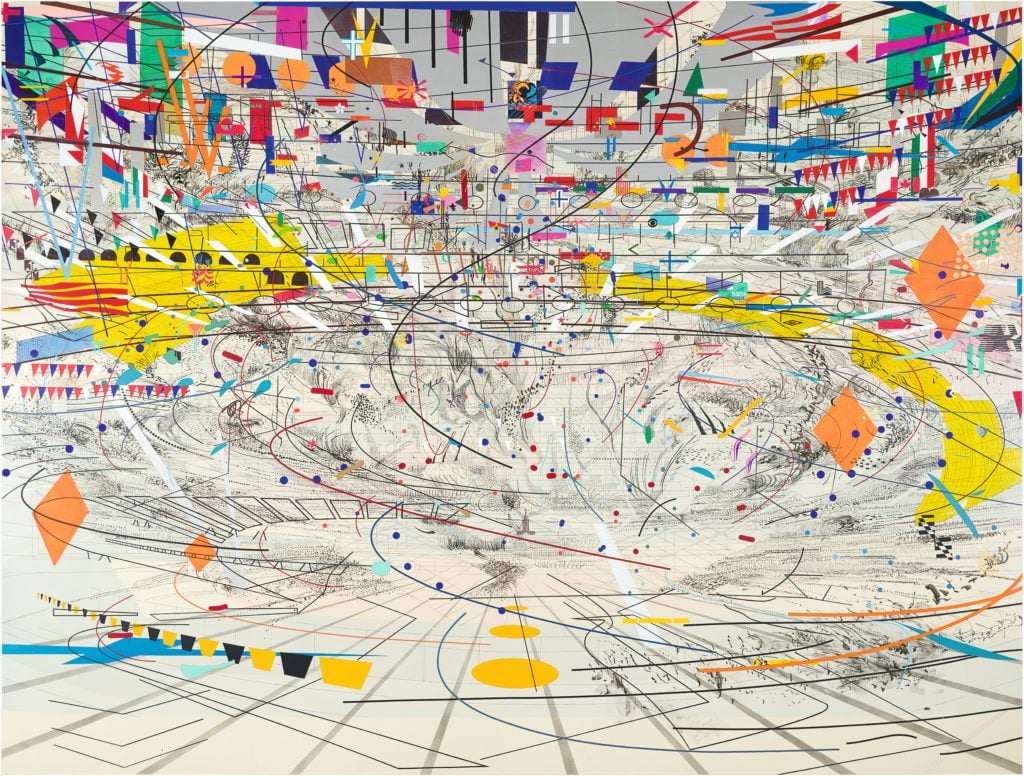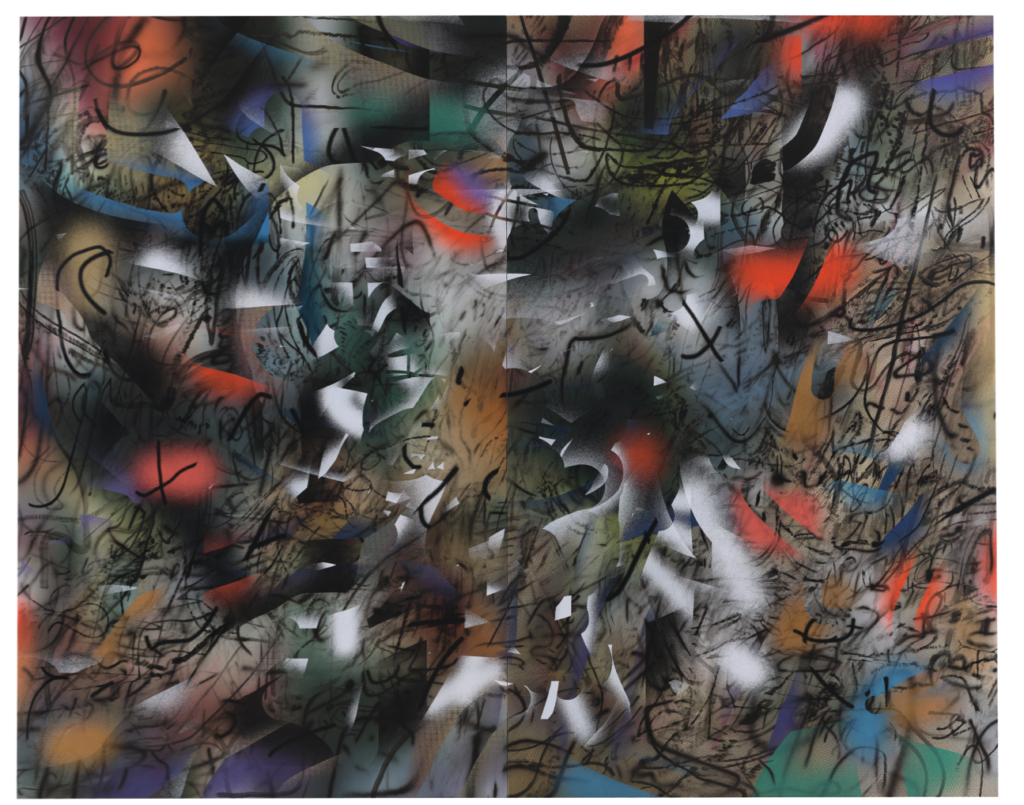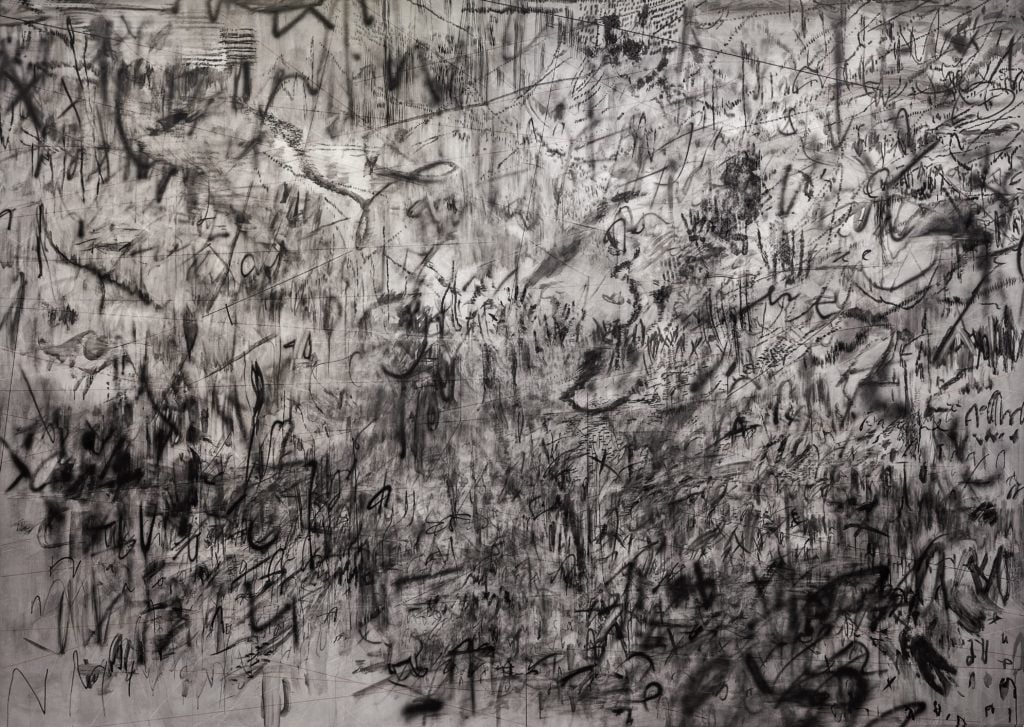Reviews
Julie Mehretu’s New LACMA Survey Reveals an Artist at the Peak of Her Power—But Also One Unusually Eager to Share the Credit
The artist remaps strategies of power both on and off the canvas.

The artist remaps strategies of power both on and off the canvas.

Catherine Wagley

Up close, Julie Mehretu’s large-scale paintings are formidable in their detail—the masterful layers of small marks filling 15- or 20-foot expanses of canvas. They are especially impressive for viewers in Los Angeles, where no gallery or institution has presented a solo show of Mehretu’s work since 2003, when a traveling exhibition stopped off at the downtown space RedCat.
But the most telling works in her new mid-career survey at the Los Angeles County Museum of Art, titled simply “Julie Mehretu,” may well be the smallest: tiny indexes made on 5-by-5-inch mylar and installed in a side gallery. These gridded drawings from 1997 served as keys for the invented characters Mehretu would incorporate into her complex, map-like drawings. Some of these characters resemble little insects, double arrows, wishbones, danger signs, or melting ghosts. They appear in her early drawings and paintings as streams of migrating marks that, from a distance, mimic the contours of cityscapes or mountain passes. But examined more closely, they look like advancing armies of weird, invented, and shifting personalities—as in Untitled (yellow with ellipses) (1998), in which arrow-like characters move in from all directions.
For years, Mehretu has referred to her paintings as “story maps of no location,” which sounds aptly poetic and conjures a whole history of artists whose imaginary mapping left them labeled as radical, weird, or outsider. Folk artist Martin Ramirez repeated a series of intuitive marks in cosmologies; Channa Horowitz’s precise invented systems were obsessive attempts at world-making; Mark Lombardi’s conspiratorial mind-maps relied on consistent sets of marks. So, too, does Mehretu’s methodology call to mind literary experiments: Jamaican poet Kei Miller’s treatment of cartography as metaphor and Sarah M. Broom’s mythic mapping of New Orleans.
Yet Mehretu’s mainstream success over the past decades—she won a MacArthur genius grant in 2005 and her work grosses more at auction than most other living female artists—means her art now looks, at first glance, famous and familiar. This makes it harder to remember that she belongs as much to this lineage of world-building obsessives as to that flashier dynasty of 20th-century abstraction.

Julie Mehretu, Haka (and Riot) (2019). Courtesy of the artist and Marian Goodman Gallery, New York, © Julie Mehretu, photograph by Tom Powel Imaging.
This survey, which was curated by Los Angeles County Museum curator Christine Y. Kim and Whitney Museum assistant curator Rujeko Hockley (it travels to the Whitney next summer), opens with a quartet of paintings: the “Mogamma” series from 2012. Mehretu, who did a number of works informed by the Arab Spring, based the title off the Mogamma government building in Tahrir Square in Cairo. In each of the approximately 15-foot tall paintings, the Cairo building’s architecture collapses into cityscapes from other sites of protest: Meskel Square in Addis Ababa, New York’s Zuccotti Park, and the Red Square in Moscow. But migrating and swirling black and gray marks, alongside diagonal lines of brightly colored acrylic, obscure the contours of these iconic places. The buildings become stately, complex backgrounds for this other less legible but more vibrant on-canvas activity.
Mehretu, who was a young child when she and her parents moved to Michigan to escape the Ethiopian Revolution, often mentions that experience as a defining one. In fact, her 2003 painting Transcending: The New International, takes different sites of revolution in Ethiopia as again-obscured subjects. In this work, armies of tiny characters and lines of ink arc outward from the middle, as if grayscale fireworks have exploded over top of lightly rendered architecture. Works like Transcending and the “Mogamma” series have no one focal point, making the movement seem much more important than the imagery.
Mehretu deviated from this horizontal compositional approach most notably in the mid-2000s, with her “Stadia” paintings, two of which appear here. Based on the structure of stadiums, these centrifugal compositions have the effect of making all the layers, including the banner-like acrylic shapes floating on top, feel as though they’re in service to the same festive central narrative. The layers seem merely formal, and thus less interesting. Luckily, the survey favors Mehretu’s impossible attempts to get at complex social realities through her imaginary, de-centered mapping—in Invisible Sun (algorithm 4, first letter form) (2014), the artist’s own language of dark heavy marks overwhelms any trace of recognizable architecture.

Julie Mehretu, Invisible Sun (algorithm 4, first letter form) (2014). ©Julie Mehretu, photo by Carolina Merlano.
The exhibition ends with Mehretu’s most recent work, which, while still decentered, moves into a space of loud colorful, airbrushed abstraction that uncomfortably conjures work of Albert Oehlen or late Sigmar Polke. Yet Mehretu narrowly sidesteps the grandstanding that made her pseudo-Expressionist predecessors insufferable by refusing to treat any one mark as particularly heroic. For instance, in Haka (and Riot) (2019), a work initially based off photos from inside a child migrant detention facility, flares of bright white spray paint spread out across an otherwise dark and dense terrain of colored and black marks, like flashbulbs going off indiscriminately all at once.
The artist Glenn Ligon, a friend of Mehretu’s, has written that if her recent works “no longer evoke collective action by a mass of characters,” her marks reflect the “myriad ways in which people attempt to resist the forces seeking to annihilate them.” In other words, her recent canvases, if bolder and more openly expressive, represent collections of defiant strategies.
But maybe the most defiant thing about them is that they are made with the help of many hands other than Mehretu’s, and while she remains the protagonist in the story of her artwork’s making, she often uses “we” when describing various projects. Her production manager, Damien Young, features prominently in the informative video playing in the museum galleries, his on-canvas work interspersing and making way for hers. If she can, from her position of influence, assert that art making at this scale is and should be seen as a collective act, it may be the greatest contribution she can make to destabilizing an art world still too in thrall to grand gestures.